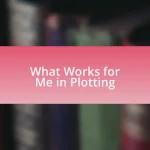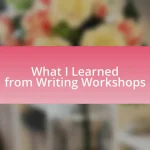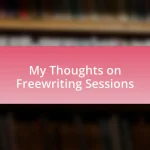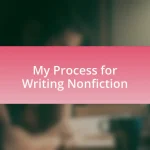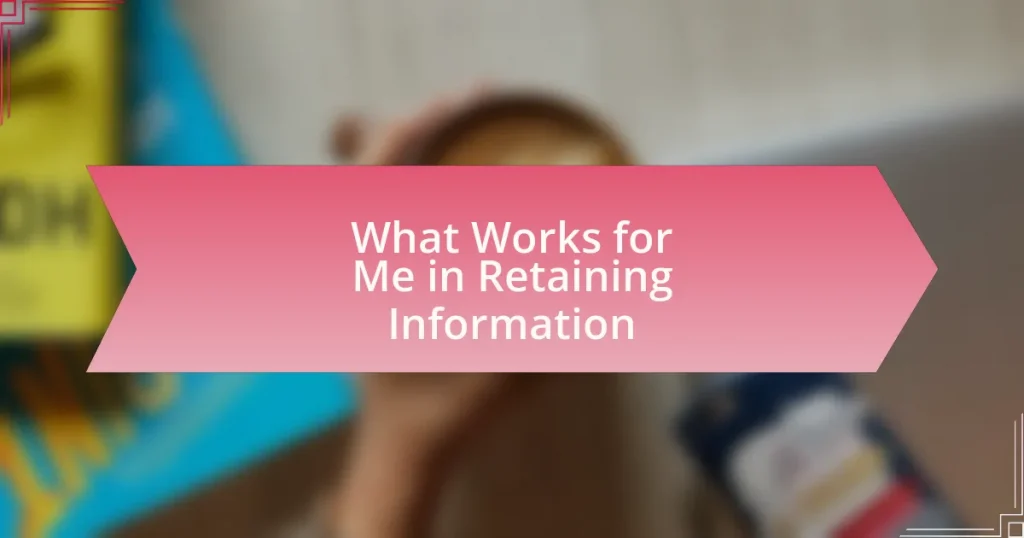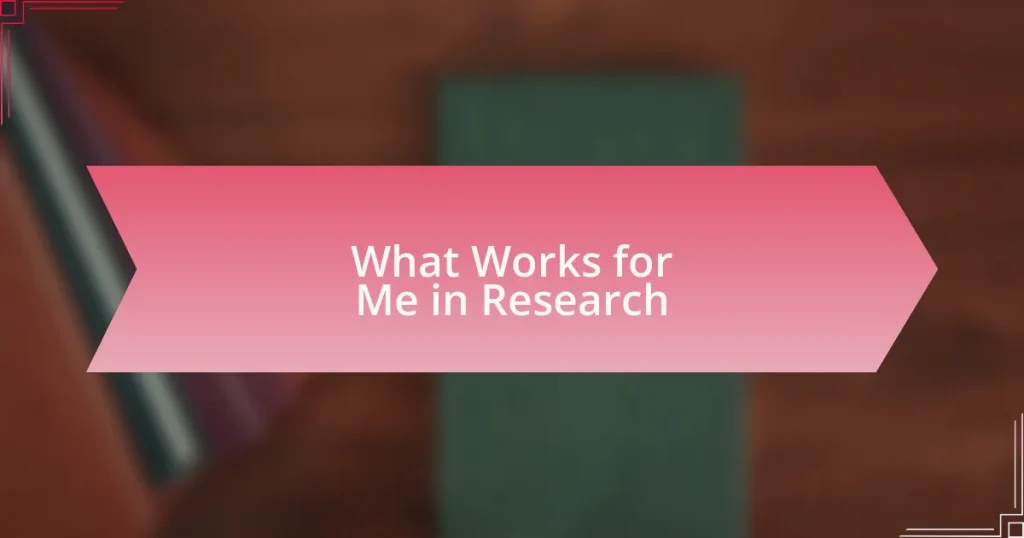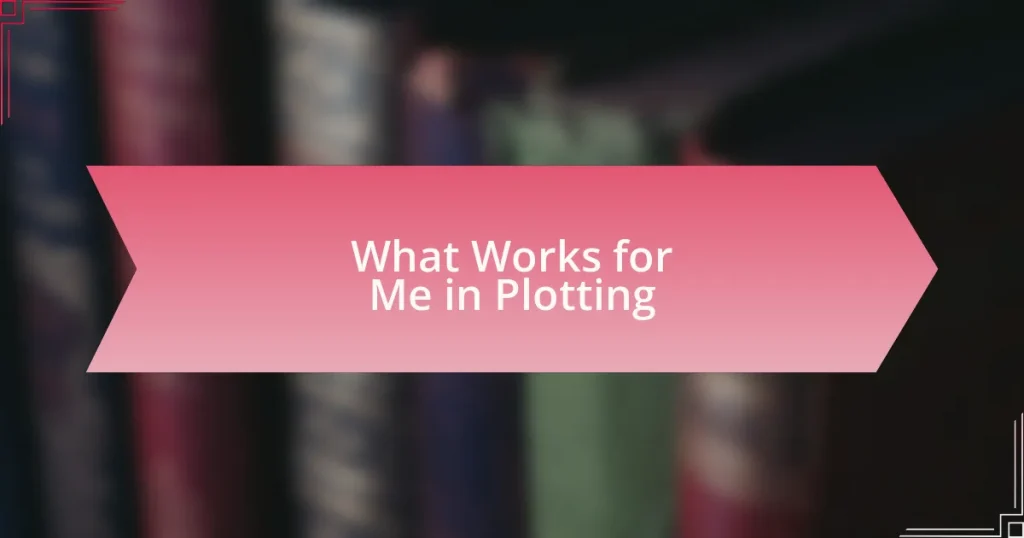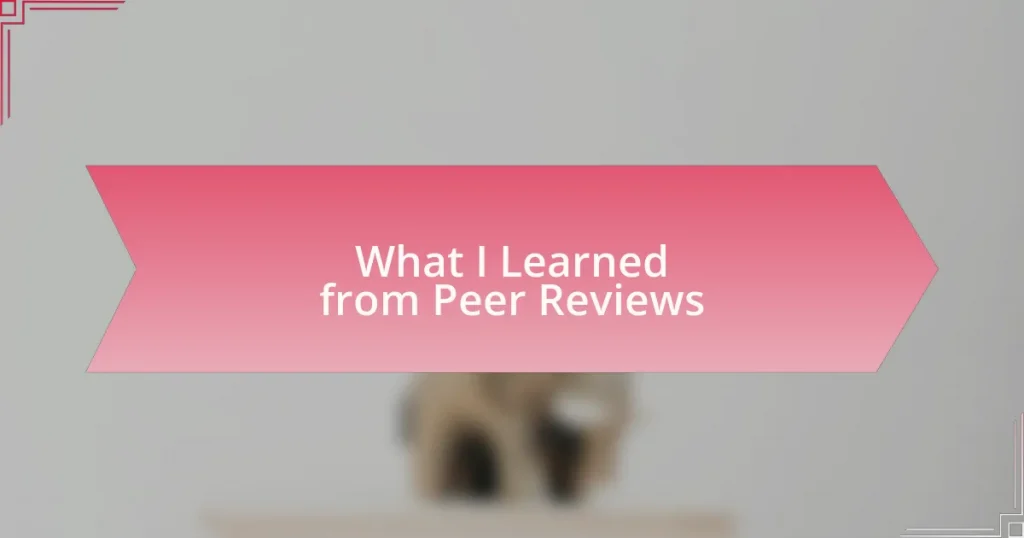Key takeaways:
- Connecting new information to personal experiences enhances memory retention and understanding.
- Teaching others reinforces one’s own learning and strengthens the grasp of concepts.
- Creating a structured study routine and employing techniques like spaced repetition improves information retention.
- Using visual aids and personal touches in study materials makes learning more engaging and memorable.
Author: Clara Whitfield
Bio: Clara Whitfield is a captivating storyteller and acclaimed author known for her rich, character-driven narratives that explore the complexities of human relationships. With a background in psychology and a passion for literature, Clara weaves intricate plots that resonate with readers on multiple levels. Her debut novel, “Echoes of the Heart,” received critical acclaim and was a finalist for several literary awards. When she’s not writing, Clara enjoys hiking in nature, experimenting in the kitchen, and engaging with her vibrant community of fellow writers. She resides in Portland, Oregon, where she draws inspiration from the lush surroundings and eclectic culture.
Understanding Information Retention
Retention of information is a fascinating process that varies significantly from person to person. I remember a time in college when I struggled to remember facts for exams. It made me wonder: what truly sticks in our minds, and why do some details seem to float away so easily?
For me, connecting new information to something I already understand has proved incredibly effective. When I learned about English idioms, I paired each one with a personal story or event—suddenly, those phrases became part of my own narrative. Have you ever noticed how recalling a moment can trigger a cascade of related memories? It’s like unlocking a door to a room full of insights.
Another technique I’ve found useful is teaching others what I’ve learned. When I explain concepts to friends, it reinforces my own understanding. Have you ever experienced the satisfaction of simplifying a complex topic for someone else? It not only solidifies your grasp but also transforms information into a shared experience—one that becomes much harder to forget.
Importance of Retaining Information
Retaining information is crucial in both personal and professional contexts. I recall a particularly important presentation at work where I struggled to remember key statistics. The anxiety I felt as I spoke was palpable, and I realized then how much retaining details can influence our confidence and effectiveness when communicating.
Moreover, the impact of memory retention stretches beyond just facts; it shapes our ability to build connections. One evening, I was asked to recall an inspiring quote about perseverance. As I shared it, I felt a wave of pride, knowing that the message wasn’t just a collection of words but a principle that guided me through challenges. Isn’t it fascinating how such moments can reinforce our beliefs and motivate others as well?
In today’s fast-paced world, the ability to retain information is like having a superpower. I often think about how much time I spend absorbing new concepts, from learning languages to strategies in my career. The more I can hold onto, the more I can adapt and evolve—do you see yourself as a lifelong learner striving to keep your mental toolkit full? It’s a journey worth taking, one that enriches not just our minds but our lives.
Techniques for Effective Learning
Finding the right techniques for effective learning can make a world of difference. One method I’ve embraced is the use of spaced repetition, where I revisit information at increasing intervals. I once prepared for a language exam using this technique and noticed how much more I could recall compared to previous study sessions. Have you ever experienced the frustration of cramming only to forget everything the next week? Spacing out my study sessions made it feel less daunting and more manageable.
Another technique that has proven invaluable is connecting new concepts to what I already know. For instance, when learning new vocabulary, I try to relate words to personal experiences or stories. I remember vividly how my understanding of the word “benevolent” deepened when I associated it with a kind teacher who always stayed after class to help struggling students. Isn’t it amazing how personal connections can transform abstract concepts into something tangible and memorable?
Additionally, I find that teaching others enhances my understanding significantly. When I tutored a friend preparing for a test, I realized that explaining concepts aloud forced me to clarify my own grasp of the material. There’s something powerful about articulating knowledge to others—have you ever noticed how explaining a topic helps solidify your own learning? In my experience, this technique not only reinforces my memory but also builds a supportive learning environment.
My Personal Retention Strategies
One approach that works wonders for me is the use of visual aids. I’m a visual learner, so when I make mind maps or diagrams, it helps cement information in my brain. I vividly recall studying grammar rules by sketching out flowcharts, and it transformed the way I understood those complexities. Have you ever tried representing information graphically? It can be a game changer.
Another strategy I rely on is creating mnemonic devices. For example, when I needed to memorize the order of adjectives in English, I crafted the silly phrase “A Nasty Old Big Green Car.” This not only made the information stick but also added a bit of humor to my studying. Doesn’t it feel satisfying when you can transform something tedious into a fun challenge?
Finally, I value the power of a quiet environment for focused study sessions. I recall a time when I tried studying in a bustling café, and it was chaos! The distractions made it nearly impossible to concentrate. Since then, I choose quiet spaces and set dedicated times for study, allowing me to immerse myself fully. Have you found that your surroundings influence your ability to retain information? For me, the right setting is crucial for effective learning.
Using Visual Aids for Memory
When I incorporate visual aids into my study routine, I feel an immediate connection to the material. During a particularly challenging unit in my language course, I created a series of colorful infographics that illustrated key vocabulary and grammar points. I often find myself flipping through those visuals in my mind, long after my initial study session. Isn’t it fascinating how colors and images can trigger memories?
I’ve also noticed that using charts to categorize verbs based on their tenses enhances my understanding significantly. The other day, I sketched a timeline and plotted out various activities alongside the correct tenses; watching it come together was quite satisfying. Do you remember the last time you visually mapped out something complex? It made me feel like I was piecing together a puzzle, and that sense of accomplishment really boosted my confidence in using those verbs.
Sometimes, the most memorable visuals come from a simple doodle in the margins of my notes. I recall doodling funny characters that represented various idioms—this quirky approach made them unforgettable. It sparked joy in what could have been dull memorization. Have you found that adding a personal touch to your visuals helps solidify concepts? I genuinely believe that the more I invest emotionally in my study materials, the more effectively I retain them.
Creating a Study Routine
Establishing a consistent study routine has been a game changer for me. I typically set aside the same time each day to focus on my English studies, and it’s amazing how my brain starts to recognize this pattern. Have you noticed how setting a specific time can help you mentally prepare and get into the right mindset? For me, it feels like my brain is switching on to study mode, just like setting a timer for cooking that signals dinner time.
I also prefer breaking my study sessions into manageable blocks. For instance, I often use the Pomodoro Technique, where I study for 25 minutes and then take a 5-minute break. This method not only keeps my energy up but also adds a sense of urgency to my learning. After all, who doesn’t thrive with a bit of a ticking clock? I find that during those breaks, I can stretch, grab a quick snack, or even listen to a song, which refreshes me for the next round of studying.
Moreover, I personalize my study space to make it inviting. I decorate my desk with motivating quotes and pictures that inspire me. There’s something profoundly uplifting about being surrounded by positivity. Do you ever feel more focused in an environment that resonates with you? When my study area reflects my personality, it transforms the routine into something enjoyable, making me eager to dive into my materials instead of viewing it as a chore.
Reflecting on My Learning Journey
Reflecting on my learning journey often brings to mind that pivotal moment when I realized the importance of connecting content to my personal experiences. I vividly recall reading a book about cultural idioms, and suddenly, I could see the world through a new lens. Have you ever had that exhilarating feeling when you discover a concept that resonates deeply with your life? For me, it was a light bulb moment that underscored how context can make language come alive.
As I think back on my progress, I remember the countless times I’ve faced frustration when a vocabulary word just wouldn’t stick. In those moments, I decided to create amusing stories to anchor those tricky terms in my mind. Did you ever find that humor lightens the load of learning? I still chuckle at the ridiculous mental images I’ve conjured to remember certain words—those quirky associations often pop into my head, making recall much easier.
With each step of my journey, self-reflection has been an essential tool. I try to ask myself what worked well and what didn’t after every study session. It has made a significant difference in understanding my learning preferences. Have you ever taken a moment to assess your approach? Taking the time to reflect not only helps reframe my strategies but also nurtures a growth mindset that I find incredibly empowering.

